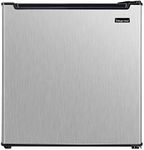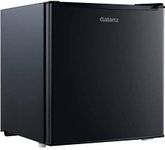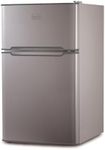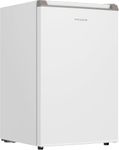Buying Guide for the Best Dorm Refrigerators
Choosing a dorm refrigerator is all about finding the right balance between size, features, and energy efficiency to fit your living space and lifestyle. Since dorm rooms are usually small and shared, it's important to consider how much food and drink you need to store, how much space you have available, and any rules your dorm might have about appliances. Think about your daily habits—do you cook often, or just need a place for snacks and drinks? This will help you decide which features matter most for you.Capacity (Size)Capacity refers to how much the refrigerator can hold, usually measured in cubic feet or liters. This is important because it determines how much food and drink you can store at once. Dorm refrigerators typically range from about 1.5 to 4.5 cubic feet. Smaller sizes (1.5–2.5 cu ft) are great for just a few drinks and snacks, while mid-sized options (2.5–3.5 cu ft) can hold a few meals and more beverages. Larger models (3.5–4.5 cu ft) are better if you plan to store leftovers or share with a roommate. Think about your eating habits and how often you shop for groceries to pick the right size for you.
DimensionsDimensions are the physical measurements of the fridge—height, width, and depth. This is crucial because dorm rooms have limited space, and you need to make sure the fridge fits where you want to put it. Measure the spot where you plan to place the fridge, and compare it to the product's dimensions. If you have very little space, look for compact or cube-shaped models. If you have a bit more room, a taller, slimmer fridge might work better. Always leave a little extra space around the fridge for ventilation.
Freezer CompartmentSome dorm refrigerators come with a small freezer section, while others do not. A freezer compartment is useful if you want to store frozen meals, ice cream, or ice cubes. However, these compartments are usually quite small and may not keep items frozen as well as a full-sized freezer. If you only need to chill drinks and snacks, you can skip this feature. If you like having frozen foods on hand, look for a fridge with a separate freezer door for better performance.
Energy EfficiencyEnergy efficiency tells you how much electricity the fridge uses. This is important because it affects your utility bills and is better for the environment. Look for refrigerators with an Energy Star rating or similar certifications, as these use less power. If you plan to keep the fridge running all year, choosing an energy-efficient model can save you money over time. If you only use it occasionally, this may be less important.
Noise LevelNoise level refers to how loud the fridge is when it's running. Since dorm rooms are small and you may be sleeping or studying nearby, a quieter fridge is usually better. Manufacturers sometimes list noise levels in decibels, but if not, you can look for reviews mentioning how quiet or loud the fridge is. If you are sensitive to noise or plan to keep the fridge close to your bed, prioritize a model known for being quiet.
Shelving and Storage OptionsShelving and storage options include the number and arrangement of shelves, door bins, and crisper drawers. Adjustable shelves let you customize the space for taller bottles or larger containers. Door bins are handy for storing drinks or condiments. If you plan to store a variety of items, look for flexible shelving. If you mostly keep drinks and small snacks, a simpler layout may be fine. Think about what you usually store in a fridge to decide which layout works best for you.
Defrost TypeDefrost type refers to how the fridge handles ice build-up. Manual defrost means you have to turn off the fridge and let the ice melt occasionally, while automatic (or frost-free) defrost does this for you. Manual defrost fridges are usually cheaper and use less energy, but require more maintenance. If you want convenience and less hassle, look for an automatic defrost model. If you don't mind occasional maintenance, manual defrost can be a good choice.










![COMFEE' 1.6 Cubic Feet Solo Series Retro Refrigerator Sleek Appearance HIPS Interior Energy Saving Adjustable Legs Temperature Thermostat Dial Removable Shelf Perfect for Home/Dorm/Garage [Black]](https://images-proxy.bestreviews.guide/JgfUf_VmqsFFKeVn_Pu2epeTMVQ=/0x150/https://m.media-amazon.com/images/I/31CQ0u9mOFL._AC_CX679_.jpg)




